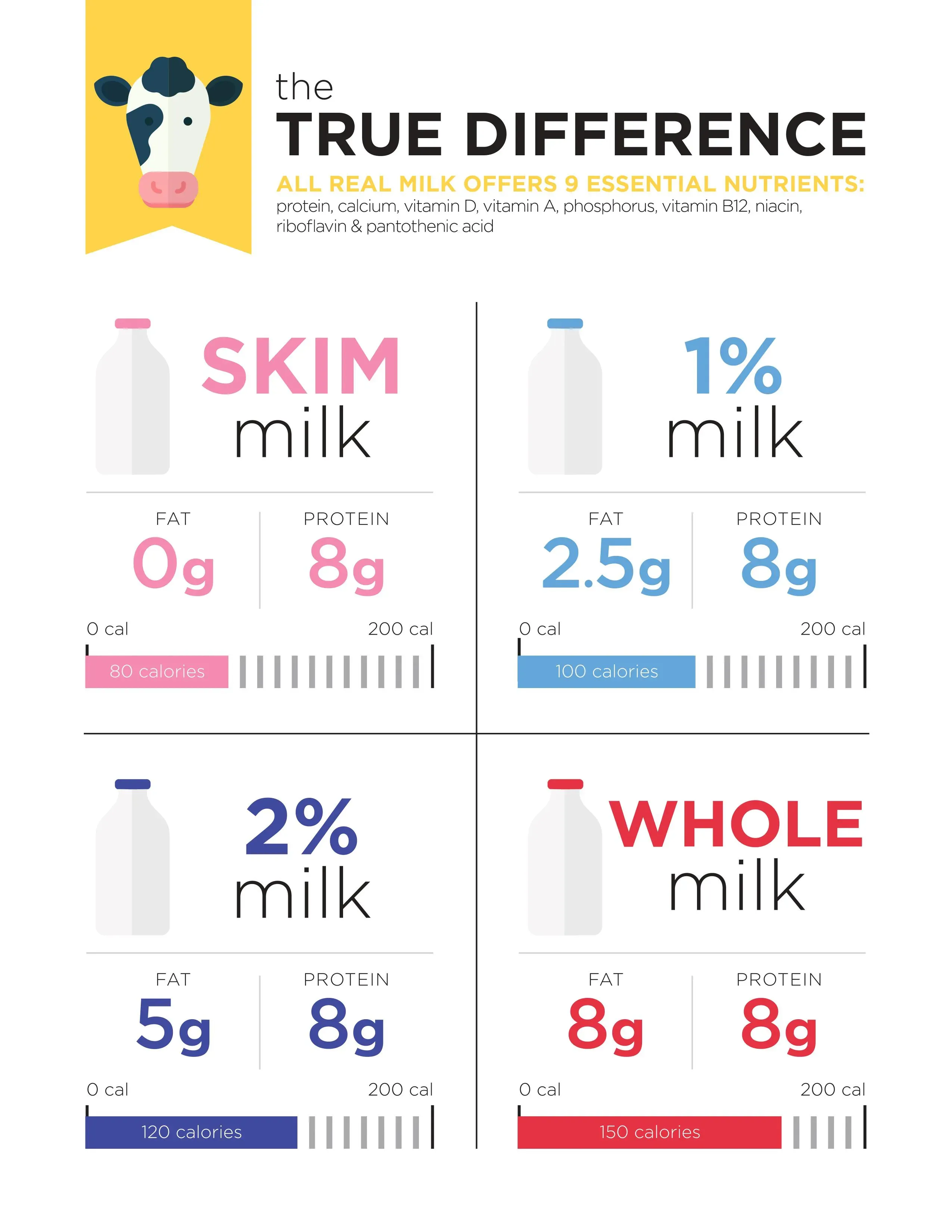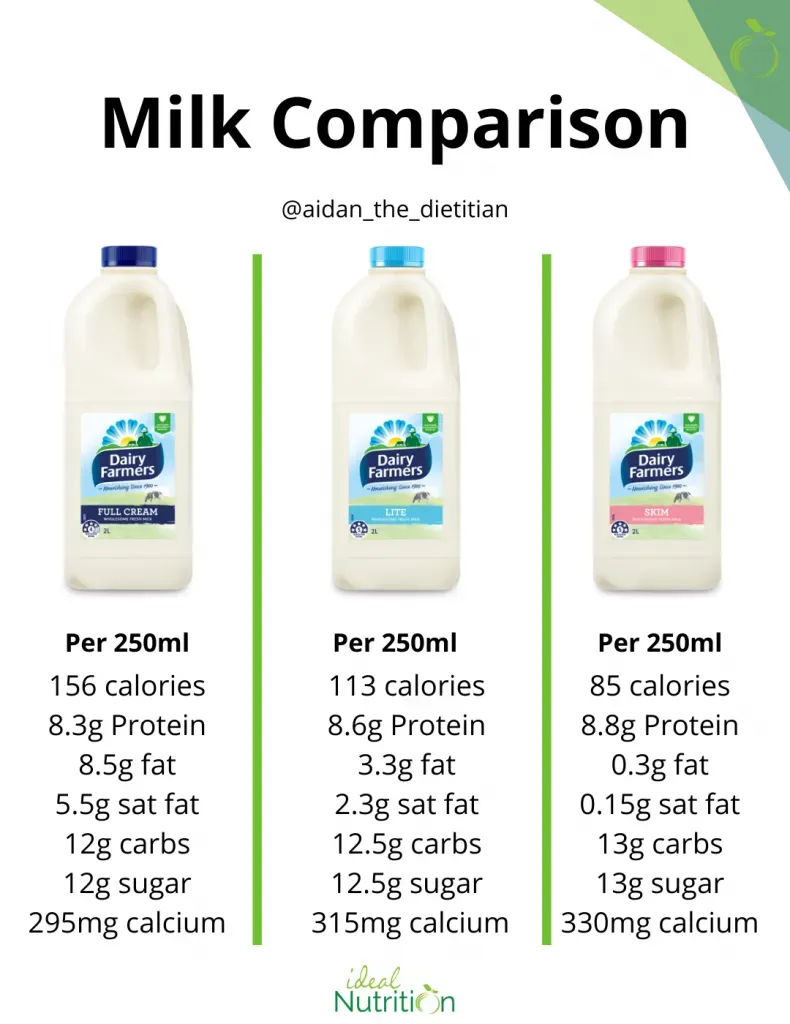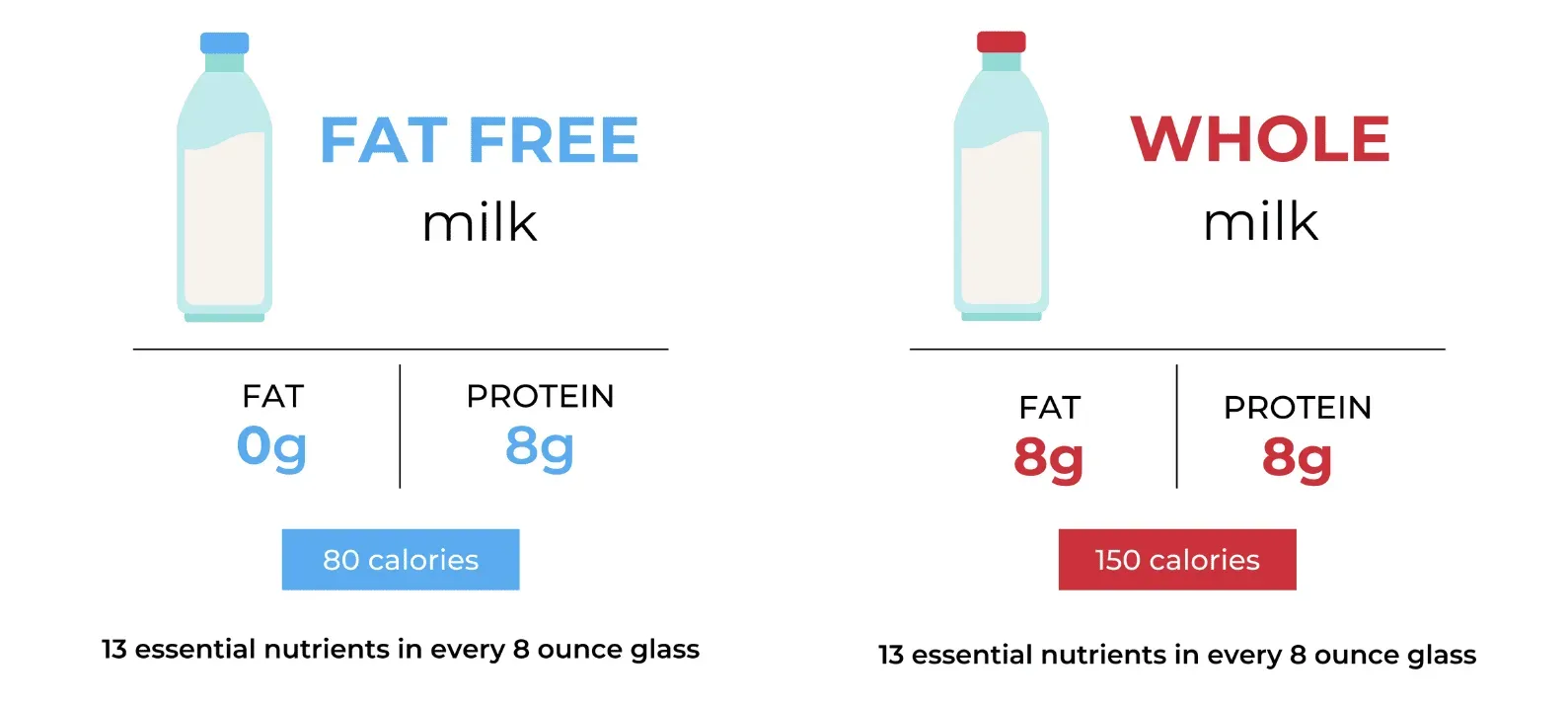Table of Contents
Standing in the dairy aisle can feel like navigating a nutritional minefield, especially when faced with the perennial question: **whole milk or low fat milk**? For decades, we've been told to ditch the full-fat versions, embracing skim or low-fat options as the virtuous choice for our hearts and waistlines. The logic seemed simple: less fat equals fewer calories and less saturated fat, which supposedly spells better health. But is that the whole story, or even the accurate story? Recent research has started pouring cold water on these long-held beliefs, suggesting the picture is far more complex than just counting fat grams.
Whole Milk vs. Low Fat Milk: What's the Real Difference?

Whole Milk vs. Low Fat Milk: What's the Real Difference?
The Obvious Split: Fat Content
Let's cut straight to the chase: the most apparent difference when comparing whole milk or low fat milk boils down to, well, the fat. Whole milk, the original unadulterated pour (after pasteurization and homogenization, of course), contains roughly 3.25% milk fat by weight. This might not sound like much, but it's enough to give it that creamy texture and rich mouthfeel many people crave. Think of it as the baseline, the standard issue. When you move to low-fat versions, things change significantly.
Engineering Your Milk: How Fat Levels Change
Low-fat milk isn't just whole milk with some fat strained out by magic. Dairy processors actually separate the cream (which holds most of the fat) from the liquid milk. Then, they add back a specific, measured amount of fat to achieve the desired percentage. Two percent milk, often called reduced-fat, clocks in at 2% milk fat. One percent milk, simply labeled low-fat, contains 1%. Skim or non-fat milk has virtually all the fat removed, landing below 0.5%. This process also often involves fortifying the lower-fat versions with vitamins A and D, which are naturally present in the fat of whole milk but lost during separation.
So, what are the standard options you'll see in the cooler?
- Whole Milk: Around 3.25% fat
- Reduced-Fat Milk (2%): Exactly 2% fat
- Low-Fat Milk (1%): Exactly 1% fat
- Skim/Non-Fat Milk: Less than 0.5% fat
Beyond the Fat: Nutritional Breakdown of Whole Milk and Low Fat Milk

Beyond the Fat: Nutritional Breakdown of Whole Milk and Low Fat Milk
Calories and Key Vitamins: More Than Just Fat
so we know the fat content is the headliner when comparing whole milk or low fat milk, but pulling apart the nutrition label reveals more nuanced differences. That extra fat in whole milk naturally means more calories per serving. A standard cup of whole milk clocks in around 150 calories, give or take, while 1% low-fat milk is closer to 100-110 calories. This calorie difference is a key point for anyone strictly tracking intake, but it's not the only story.
Remember how I mentioned lower-fat milks are often fortified? That's because vitamins A and D are fat-soluble. They hitch a ride on the fat globules in whole milk. When you strip away the fat, you strip away these crucial vitamins. So, manufacturers add them back. This means a cup of fortified low-fat milk often contains similar, if not slightly higher, amounts of added vitamin D compared to whole milk. Calcium and protein, thankfully, remain fairly consistent across the board, which is good news because milk is a solid source for both.
Protein, Carbs, and Other Goodies
Beyond the calories and fat-soluble vitamins, whole milk and low fat milk share a lot of the same fundamental building blocks. Both provide around 8 grams of high-quality protein per cup, which is essential for building and repairing tissues. The carbohydrate content, primarily in the form of lactose (milk sugar), is also quite similar, usually hovering around 12 grams per cup. So, if you're looking for protein or carbs, the fat level doesn't make a huge difference.
However, whole milk does contain naturally occurring omega-3 fatty acids, albeit in small amounts. While milk isn't a primary source of omega-3s like fatty fish, every little bit helps. Some research also points to unique fatty acids in full-fat dairy, like conjugated linoleic acid (CLA), which some studies suggest might have potential health benefits, though the evidence is still debated and not conclusive enough to base dietary choices solely on this.
Nutrient (per 1 cup) | Whole Milk (approx.) | Low-Fat Milk (1%, approx.) |
|---|---|---|
Calories | 150 | 100-110 |
Total Fat | 8g | 2.5g |
Saturated Fat | 4.5g | 1.5g |
Protein | 8g | 8g |
Carbohydrates | 12g | 12g |
Calcium | ~300mg | ~300mg |
Vitamin D (fortified) | ~2.4mcg | ~2.4mcg |
Vitamin A (fortified) | ~150mcg RAE | ~150mcg RAE |
Saturated Fat and Your Heart: Is Whole Milk or Low Fat Milk Safer?

Saturated Fat and Your Heart: Is Whole Milk or Low Fat Milk Safer?
The Long-Standing Low-Fat Dogma
For decades, the dietary advice felt pretty straightforward, almost like a commandment: saturated fat is bad for your heart, and dairy fat is loaded with it. Therefore, when choosing between whole milk or low fat milk, the low-fat option was the clear winner for anyone worried about cholesterol and heart disease. This thinking led to widespread recommendations to swap whole milk for skim or 1%. The idea was simple: cut the fat, cut the risk. Doctors and health organizations preached this gospel, and most people followed suit, stocking their fridges with the watery stuff, believing they were actively protecting their tickers.
This perspective was largely based on studies linking saturated fat intake to increased LDL ("bad") cholesterol levels, a known risk factor for heart disease. On paper, reducing saturated fat intake seemed like a no-brainer way to lower that risk. So, the dairy industry started producing and heavily marketing lower-fat options, and consumers bought into the idea that fat, any fat, was the enemy, especially the saturated kind found in whole milk.
Challenging the Conventional Wisdom on Dairy Fat
Turns out, the human body and nutrition are a bit more complicated than a simple fat-in, cholesterol-up equation. Recent research has begun to seriously question the blanket recommendation to avoid full-fat dairy. Studies, some quite large, haven't found the expected link between consuming whole milk or other full-fat dairy products and increased risk of heart attacks or strokes in healthy individuals. Some have even suggested a neutral or slightly protective effect. How can this be? Scientists are now looking at the "food matrix" – the idea that nutrients aren't consumed in isolation, but within a complex package of other nutrients, vitamins, minerals, and compounds that can influence how the body processes them.
In the case of dairy, the saturated fat in whole milk comes bundled with protein, calcium, vitamin D, and other bioactives. It's possible that these other components somehow modify the effect of the saturated fat. Think of it like this: eating a candy bar with saturated fat is different from eating a piece of cheese with the same amount of saturated fat, because the candy bar lacks the protein, calcium, and other elements present in the cheese. The context matters.
So, what are some of the emerging ideas challenging the old view?
- Dairy fat might not impact cholesterol the same way as saturated fat from other sources.
- Specific fatty acids in dairy (like CLA) could have unique effects.
- The calcium in dairy might help excrete some fat.
- Full-fat dairy can be more satiating, potentially helping with overall calorie intake.
Finding Your Balance: The Nuance of Dairy Fat
Given the evolving science, it's less about declaring whole milk or low fat milk definitively "safer" for everyone and more about understanding nuance and individual needs. For most healthy people, moderate consumption of whole milk within a balanced diet doesn't appear to pose a significant threat to heart health based on current evidence. The old fear surrounding its saturated fat content seems, at least in part, overstated when consumed as part of a whole food like milk.
However, this doesn't mean everyone should rush back to whole milk. Individuals with specific health conditions, like familial hypercholesterolemia or existing cardiovascular disease, might still need to be more cautious about saturated fat intake, and low-fat options could be a more prudent choice under medical guidance. Dietary patterns as a whole, including overall saturated fat intake from all sources (meat, butter, processed foods), matter more than singling out one food. The conversation about whole milk or low fat milk has shifted from a simple "good vs. bad" to a more complex picture where personal health context and overall diet play crucial roles.
More Than Just Calories: Whole Milk, Low Fat Milk, and Your Health Goals
Satiety and Weight Management: Does Fat Keep You Fuller?
so we've dissected the fat and debated the heart stuff. Now, let's talk about something arguably more tangible for most people day-to-day: how these milks actually make you feel and how that might tie into managing your weight. When you're looking at whole milk or low fat milk, one big difference is the satisfaction factor. Fat, as a macronutrient, is inherently more satiating than carbs or protein. It slows down digestion, making you feel fuller for longer after you drink it. Think about dipping a cookie in whole milk versus skim – the whole milk clings, it feels richer. That richness translates into a feeling of fullness that the more watery low-fat versions often lack.
This isn't just a feeling; it has practical implications. If a glass of whole milk keeps you satisfied longer, you might be less likely to snack on something else shortly after. While whole milk has more calories *per cup*, if it helps you eat less overall throughout the day because you're not hunting for the next bite, the calorie difference might not be the strict determinant of weight gain or loss you once thought. It’s about the overall dietary pattern, not just one component in isolation. It’s a bit counterintuitive to the old "fat makes you fat" mantra, but emerging evidence supports the idea that full-fat dairy doesn't necessarily hinder weight management and might even help some people feel more in control of their appetite.
Chronic Disease Risk: Beyond Just Heart Health
The conversation around whole milk or low fat milk isn't confined solely to heart health anymore. Researchers are also exploring how different types of dairy might influence the risk of other chronic conditions, particularly metabolic syndrome and type 2 diabetes. Remember that "food matrix" concept? It applies here too. The unique combination of nutrients in whole milk seems to interact in ways we are only starting to understand. Some studies have observed that people who consume full-fat dairy products tend to have a lower risk of developing these metabolic issues compared to those who opt for low-fat versions or avoid dairy altogether.
Now, correlation isn't causation, and these studies control for many other lifestyle factors, but the findings are consistent enough to warrant attention. It challenges the simple notion that removing fat automatically makes a food healthier in every context. It could be that the fat itself, or the way it interacts with other dairy components, plays a protective role in insulin sensitivity or inflammation pathways. It's a complex area of research, and nobody is saying whole milk is a magic bullet, but it certainly suggests that demonizing the fat content might have been an oversimplification that overlooked potential benefits for metabolic health.
- Whole milk's fat content may increase satiety, potentially aiding appetite control.
- Feeling fuller could lead to reduced overall calorie intake throughout the day.
- Recent research suggests full-fat dairy consumption is not linked to increased risk of metabolic syndrome or type 2 diabetes.
- The "food matrix" of whole milk might offer protective effects beyond just its individual nutrients.
- Consider your personal health goals and how different milks fit into your overall dietary pattern.
Choosing Your Pour: Deciding Between Whole Milk or Low Fat Milk

Choosing Your Pour: Deciding Between Whole Milk or Low Fat Milk
It's Not a Universal Decree, It's Your Decree
Alright, so we've waded through the fat percentages, the calorie counts, the vitamin fortification, and even the evolving science on saturated fat and chronic disease. After all that, you might be thinking, " but which one do *I* actually choose?" The slightly annoying, but honest, answer is: it depends. There's no single, one-size-fits-all answer to the whole milk or low fat milk debate. What's right for your neighbor, your best friend, or the latest health guru online might not be the best fit for you. Your age, your overall diet, your activity level, any underlying health conditions, and even your personal taste preferences all factor into the equation. Trying to force yourself to drink skim milk if you genuinely dislike it might lead to you avoiding milk altogether, missing out on its protein and calcium. Conversely, if your diet is already heavy in saturated fats from other sources, maybe scaling back on milk fat makes sense for you.
Think about your priorities. Are you focused purely on minimizing calories? Then the lower-fat options clearly win on that metric per cup. Are you trying to feel more satisfied after breakfast? Whole milk's fat might help with that. Are you concerned about getting enough fat-soluble vitamins without fortification? Whole milk naturally contains them. It's less about adhering to outdated dogma and more about making a conscious choice that aligns with your individual needs and how the milk fits into your entire day's worth of eating.
Considering Your Personal Health Landscape
Beyond just preference and general health goals, your specific medical situation absolutely plays a role in choosing whole milk or low fat milk. If your doctor has told you to strictly limit saturated fat due to high cholesterol or heart disease, sticking to lower-fat versions is likely the prudent move. That's not the time to experiment with the "food matrix" theory based on an internet article, no matter how well-written (ahem). If you're pregnant or breastfeeding, nutrient density becomes even more critical. For kids, especially toddlers, the fat in whole milk is important for brain development, and pediatricians often recommend it unless there's a specific reason not to.
Ultimately, this decision isn't set in stone forever. You can try one for a while and see how you feel. Does switching to whole milk make you feel more satisfied? Does low-fat milk leave you feeling hungry quickly? Pay attention to your body. And if you have any significant health concerns or are managing a chronic condition, the best person to guide your choice between whole milk or low fat milk is always a registered dietitian or your doctor. They can look at your complete health profile and help you figure out the best pour for your personal pitcher.
So, when you're standing there, carton in hand, ask yourself:
- What are my main health goals right now?
- How does this milk fit into my overall diet today?
- What does my body (and my taste buds) prefer?
- Have I discussed specific dietary needs with a health professional?
Pouring Your Own Path: Making the Milk Choice
So, where does that leave us in the whole milk or low fat milk debate? The simple answer is, it's not so simple anymore. The long-standing dogma pushing low-fat as the only healthy option appears overly reductionist. Whole milk isn't the dietary bogeyman it was once portrayed as for many people. Its higher fat content brings different nutrients and can contribute to satiety, potentially aiding weight management in some contexts. Low-fat milk remains a solid, nutrient-dense choice, especially for those needing to limit calorie or fat intake strictly. Ultimately, the decision hinges on your individual dietary needs, overall eating pattern, and personal preferences. There's no universal "better" milk; there's just the milk that best fits your life and health goals right now.
